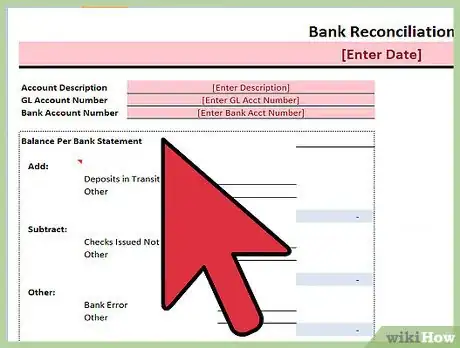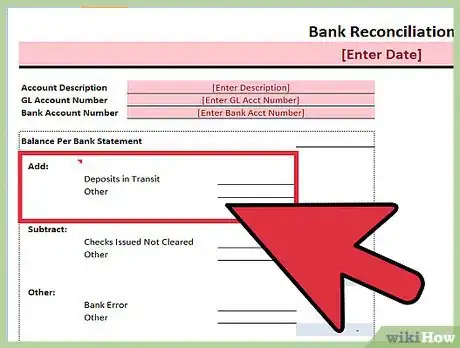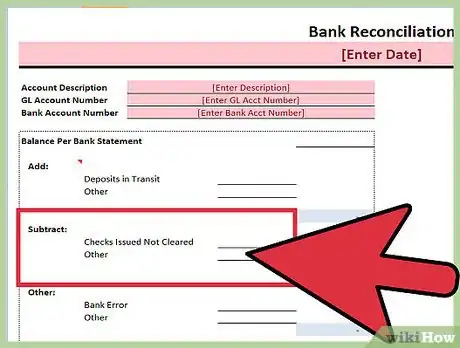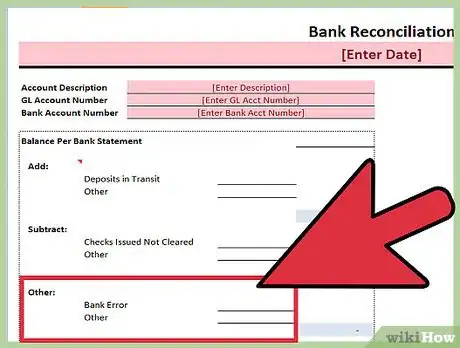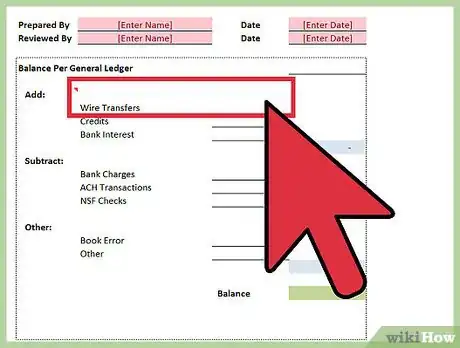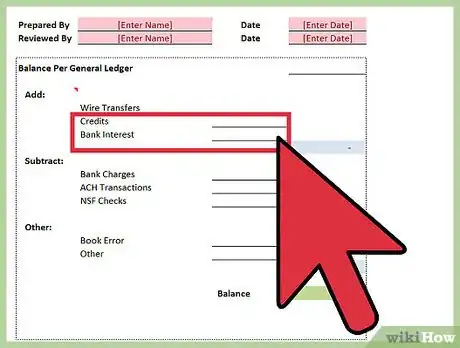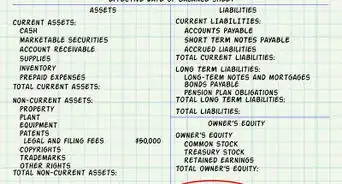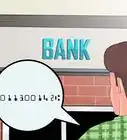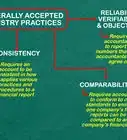This article was co-authored by Jill Newman, CPA. Jill Newman is a Certified Public Accountant (CPA) in Ohio with over 20 years of accounting experience. She has experience working as an accountant in public accounting firms, nonprofits, and educational institutions, and has also honed her communication skills via an MA in English, writing jobs, and as a teacher. She received her CPA from the Accountancy Board of Ohio in 1994 and has a BS in Business Administration/Accounting.
There are 8 references cited in this article, which can be found at the bottom of the page.
wikiHow marks an article as reader-approved once it receives enough positive feedback. This article received 17 testimonials and 87% of readers who voted found it helpful, earning it our reader-approved status.
This article has been viewed 626,772 times.
A bank reconciliation is a critical tool for managing your cash balance. Reconciling is the process of comparing the cash activity in your accounting records to the transactions in your bank statement. This process helps you monitor all of the cash inflows and outflows in your bank account. The reconciliation process also helps you identify fraud and other unauthorized cash transactions. As a result, it is critical for you to reconcile your bank account within a few days of receiving your bank statement.
Steps
Adjusting the Bank Statement Balance
-
1Examine the bank statement balance. Access your bank statement as soon as possible. If you have online access to your account, your bank statement should be available shortly after that last day of the month. When you get the statement, note the month-end balance. Your goal is to reconcile any differences between the bank balance and your cash account records.[1] This means checking whether each transaction appears both in your own records and on your bank statement.
- In a bank statement, debits refer to withdrawals from the bank account, and credits refer to deposits to the bank account. These definitions are different from how the accounting profession uses these terms.
- If an item appears only in one place (the bank statement or your cash account), it is a "reconciling item". Your goal is to identify the reason the two records don't match, and correct them until they do.
- A bank reconciliation can be thought of as a formula. The formula is (Cash account balance per your records) plus or minus (reconciling items) = (Bank statement balance). When you have this formula in balance, your bank reconciliation is complete.
- Your cash account balance defined as your book balance (or balance per book). The bank statement balance is the balance per bank. The difference between these two balances is due to reconciling items.
-
2Increase the bank balance for any deposits that have not posted (also known as deposits in transit). There may be a delay between the time you make a deposit at the bank, and the time the deposit is posted as an increase to your bank account. If you deposit funds at an ATM or at the bank branch, the delay may be brief. If you mail a deposit, the delay can be longer.[2]
- You increase your cash account for the amount of the deposit immediately. The bank's delay in posting the deposit means that you have a reconciling item.
- The bank statement balance would need to be credited (or increased) to reflect the true amount of cash. [3]
- For example, assume your bank balance was $5,000. You deposited $1,500 on July 31st. Your July bank statement does not include the $1,500 deposit. To reconcile the balance, you would add $1,500 to the bank statement balance, increasing the bank balance to $6,500. The $1,500 is a reconciling item.
Advertisement -
3Decrease the bank balance for all outstanding checks. A cleared check refers to a check that has posted to the bank's records. Any check that has not been cleared by the bank is called an outstanding check. This situation occurs when checks are written in the last day or two of the month. Outstanding checks need to be deducted from the bank balance.[4]
- Assume that the bank balance is $5,000. To account for deposits properly, you increase the bank balance for $1,500 in deposits in transit. Your change adjusts the bank balance to ($5,000 + $1,500 = $6,500).
- Say that 5 checks totaling $3,000 are outstanding at the end of the month. To account for outstanding checks, you decrease the adjusted bank balance by $3,000. Your new adjusted bank balance is ($6,500 - $3,000 = $3,500).
- Make sure to check the prior month's statement as well to ensure that any outstanding checks from the previous period have cleared this month. If a check has yet to clear, contact the payee (the person who should receive the payment) to learn why. If the check is still outstanding after a month, it may be lost.
-
4Check for any errors made by the bank's processing department. If you're reconciling a business cash account, your accounting is posted to general ledger. A business should compare the cash account's general ledger to the bank statement activity. You may come across a transaction that you cannot fully explain. If you're unclear about a business or personal bank transaction, contact your bank.[5]
- One possible error comes from "transposing," or reversing the numbers on a deposit amount or check. For example, the bank may mistakenly record a $570 deposit instead of a $750 deposit. This always results in an error that is a multiple of nine ($180 in this example). Contact your bank and ask them to make a correction to remove the reconciling item.
- If the discrepancy isn't a bank error, it may represent fraudulent activity. Assume that a secretary manages a dental office. The checkbook is on the front desk when the secretary is at lunch. A visitor steals a check from the checkbook and cashes it.
- When the check posts to the bank account, it is a fraudulent transaction. Assume also that the dentist notices the cashed check in the bank statement. The dentist calls the bank, and the bank adds funds back to the account. That removes the reconciling item.
Adjusting the General Ledger Balance
-
1Verify that all checks have posted. When your company receives the bank statement, you should print a report listing all of the checks written and deposits made during the month. A company will probably have accounting software that can provide reports.
- If you're reconciling your personal bank account, you should review your check register and your deposit slips. A company should print the cash reports, and also review the check register and deposit slips.
- Review all of the checks you have written in numbered order. Verify that the check posted to your bank statement. If the check cleared your bank, indicate that in your records. You can document the cleared check using accounting software, or using a manual report.
- You should also review checks written in the prior month. Review to see if those checks posted to the current month's bank statement. If the check cleared, indicate that fact in your records. If the check has not cleared, contact the payee. The check may be lost.
- When you finish your review, you should create a list of each check that has not posted to the bank account. That list should include the check number, the dollar amount and the payee.
- The total dollar amount represents your outstanding checks for the month. Outstanding checks are a reconciling item.
-
2Confirm that all deposits have posted. A business should print a list of all deposits made for the month. The company should also review all deposits slips. If you're reconciling your personal account, you should have a list of deposits in your checkbook- along with your deposit slips.[6]
- When you receive your bank statement, review the deposits that posted to the bank's records for the month.
- Review all of your checkbook deposits in order by date. Confirm that each deposit posted to the bank statement.
- You should also review any deposits in transit at the end of the prior month. Confirm that those deposits posted to the bank statement for the current month.
- When you finish your review, you should create a list of each deposit that has not posted to the bank account. That list should include the deposit amount and the date of the deposit.
- The total dollar amount represents your deposits in transit for the month. Deposits in transit are a reconciling item.
-
3Subtract any service charges and automated debits. You need to deduct all bank charges from your cash account. One type of bank charge is a monthly service charge. You may also be charged if you overdraw your account balance. Most of these charges are posted to your bank statement, but may not be posted to your cash account at month-end. You also need to adjust your cash records for interest earned on your bank account balance.[7]
- If a $10 service fee is posted to the bank statement, for example, it would need to be deducted from the cash account. Until you post the amount to your cash records, it is a reconciling item.
- Add any interest earned on your account balance. You don't typically know about interest your account has earned until a bank statement arrives. Add any interest the bank has credited to your cash account balance. Until you post the interest to your records, the amount is a reconciling item.
- Deduct any automatic payments. Many accounts may have automatic monthly payments set up for certain recurring bills. If you don't have the payment date for auto payments on your calendar, you may not see the withdrawal until it appears on the monthly bank statement. Review your bank statement. Post any missing automated debit payments to your cash account. This step will remove a reconciling item.
- Deduct any NSF checks. If the bank statement indicates that a “not sufficient funds” check bounced during the month, that means that the check amount was not deposited to your account. You will have to deduct the check amount from your cash account records. If the bank charges you a fee for depositing a bad check, you will also need to deduct that amount. You will also be charged if you overdraw your account.
-
4Check for any errors you've made during the month. As you compare your cash account activity to the bank, you may find errors that you made. For example, you might post the wrong dollar amount for a check or deposit to your cash records. Those errors will create a reconciling item.[8]
- If your balance is off by a multiple of nine (for example, $270 or $630), you have likely made a transposition error. This means you accidentally switched the order of two digits in a deposit. For example, you may have filled out a check for $310 but recorded it in your records as $130.
- Once you finish all of your reconciliation work, your (cash account balance) plus or minus all (reconciling items) should equal the (balance per the bank statement). If that formula does not equal, review your work until you account for all of the reconciling items correctly.[9] [10] [11]
Expert Q&A
Did you know you can get expert answers for this article?
Unlock expert answers by supporting wikiHow
-
QuestionHow do I prepare a bank reconciliation without a bank statement?
 Jill Newman, CPAJill Newman is a Certified Public Accountant (CPA) in Ohio with over 20 years of accounting experience. She has experience working as an accountant in public accounting firms, nonprofits, and educational institutions, and has also honed her communication skills via an MA in English, writing jobs, and as a teacher. She received her CPA from the Accountancy Board of Ohio in 1994 and has a BS in Business Administration/Accounting.
Jill Newman, CPAJill Newman is a Certified Public Accountant (CPA) in Ohio with over 20 years of accounting experience. She has experience working as an accountant in public accounting firms, nonprofits, and educational institutions, and has also honed her communication skills via an MA in English, writing jobs, and as a teacher. She received her CPA from the Accountancy Board of Ohio in 1994 and has a BS in Business Administration/Accounting.
Financial Advisor You can view your bank activity online, or ask a bank clerk for a printout of activity during the time period you are reconciling. The printout usually includes the bank account's balance as of the date you are reconciling. If necessary, you can find the balance yourself by starting with the previous month's ending balance, then adding and subtracting based on the activity listed on the printout. Once you have the final balance for that time period, you will then compare items from your personal or business register as in a standard bank reconciliation.
You can view your bank activity online, or ask a bank clerk for a printout of activity during the time period you are reconciling. The printout usually includes the bank account's balance as of the date you are reconciling. If necessary, you can find the balance yourself by starting with the previous month's ending balance, then adding and subtracting based on the activity listed on the printout. Once you have the final balance for that time period, you will then compare items from your personal or business register as in a standard bank reconciliation. -
QuestionWhere should the petty cash transaction be in a bank reconciliation statement?
 Jill Newman, CPAJill Newman is a Certified Public Accountant (CPA) in Ohio with over 20 years of accounting experience. She has experience working as an accountant in public accounting firms, nonprofits, and educational institutions, and has also honed her communication skills via an MA in English, writing jobs, and as a teacher. She received her CPA from the Accountancy Board of Ohio in 1994 and has a BS in Business Administration/Accounting.
Jill Newman, CPAJill Newman is a Certified Public Accountant (CPA) in Ohio with over 20 years of accounting experience. She has experience working as an accountant in public accounting firms, nonprofits, and educational institutions, and has also honed her communication skills via an MA in English, writing jobs, and as a teacher. She received her CPA from the Accountancy Board of Ohio in 1994 and has a BS in Business Administration/Accounting.
Financial Advisor The withdrawal for petty cash will show up on your bank statement as a withdrawal, or as a cleared check if you made it payable to "Cash." Reconcile this with your own records the same as you would any other withdrawal. The details of how the petty cash is spent and how much money is left in the petty cash fund are not part of the bank reconciliation.
The withdrawal for petty cash will show up on your bank statement as a withdrawal, or as a cleared check if you made it payable to "Cash." Reconcile this with your own records the same as you would any other withdrawal. The details of how the petty cash is spent and how much money is left in the petty cash fund are not part of the bank reconciliation.
References
- ↑ http://www.accountingtools.com/questions-and-answers/what-is-the-purpose-of-a-bank-reconciliation.html
- ↑ https://www.youtube.com/watch?v=aeOOZdLTX0s
- ↑ https://www.playaccounting.com/explanation/brs-exp/bank-reconciliation-statement/
- ↑ http://accountingexplained.com/financial/cash-and-equiv/bank-reconciliation
- ↑ https://www.youtube.com/watch?v=aeOOZdLTX0s
- ↑ http://docs.oracle.com/cd/E39583_01/fscm92pbr0/eng/fscm/fsbk/concept_UnderstandingBooktoBankReconciliation-9f258f.html
- ↑ http://accountinginfocus.com/financial-accounting/cash-financial-accounting/cash-bank-reconciliations/
- ↑ https://www.youtube.com/watch?v=aeOOZdLTX0s
- ↑ https://www.youtube.com/watch?v=BoSZZCUP_iA
About This Article
To prepare a bank reconciliation, gather your bank statement and a list of all of your recent transactions. Compare your debits, or withdrawals from your bank account, and credits, or deposits you made into your account, to ensure that the transactions appear in both your records and on your bank statement. If you find an error on the bank’s part, contact them as soon as possible to let them know about the discrepancy. Keep reading for advice from our CPA reviewer on how to account for service fees and bank statements!
